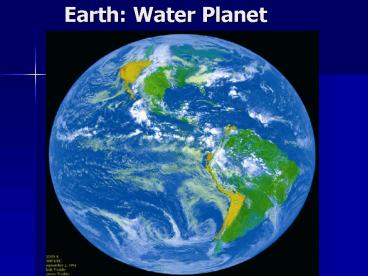Earth: Water Planet PowerPoint PPT Presentation
1 / 29
Title: Earth: Water Planet
1
Earth Water Planet
2
Essential Questions
- How does water get recycled through the
atmosphere? - What are the properties of water that make it a
unique compound? - What creates acid rain?
- What factors cause water pollution?
- How does water move on the earths surface and
below the ground?
3
Water facts
- Water is essential to our planet's life and
without it nothing could survive. - The globe is two-thirds covered by water, but 93
is ocean water, toxic to humans, plants and
animals. - There is the same amount of water on earth now as
there was when dinosaurs hung out at the local
pond millions of years ago. - The water keeps moving in a cycle it evaporates
from rivers, lakes, and oceans. - The vapor from evaporation and condensation forms
the clouds in the sky and then returns to earth
as rain, snow, sleet, or hail. - About two-thirds of your body is made up of
water. - The Earth's water supply is made up of 97
oceans, 2 Icecaps/Glaciers, 1Fresh Ground
Water. - Water is the only thing that can be a gas,
liquid, and a solid. - In 20 minutes, one thunderstorm can send down
over 125,000,000 gallons of water!
http//ga.water.usgs.gov/edu/sc3.html
4
Chemical and Physical Properties of Water
- Formula H2O
- Polar Molecule
- Universal solvent, dissolves many polar
substances - High surface tension
- Boiling point 100oC
- Freezing and melting point 0oC
http//ga.water.usgs.gov/edu/sc3.html
5
Water and the Hydrologic Cycle
6
Explain how solar energy causes water to cycle
through the major earth reservoirs
- Water molecules evaporate into the air as water
vapor - Water evaporates from ocean and land surfaces
- Transpiration is water vapor lost from plant
leaves
7
HYDROLOGIC CYCLE
8
Water Terms
- Evaporation
- Condensation
- Precipitation
- Transpiration
- Run-off
- Infiltration
- Water cycle
- Watersheds
- Sublimation
- Permeability
- Acid precipitation
- Oceans
- Salt water
- desalination
- Fresh water
- Rivers
- Lakes
- Streams
- Glaciers/icebergs
- Aquifer
- Aquitard
- Ground water
- Salt water
9
AQUIFER DIAGRAM
10
(No Transcript)
11
TOPOGRAPHY
12
How to read a Topographic Map
- Contour Lines join points of equal elevation
- Close Lines steep slope
- Can determine physical and man-made features of
earth surface
http//interactive2.er.usgs.gov/learningweb/teache
rs/mapsshow_act4.htm
13
- POLLUTION DEFINED
- A pollutant is a substance that once it gets
into the environment, tends to elevate the
"natural" background level of that substance. - The pollutants get into water from both rural and
urban activities. - The main six types of pollutants that reduces the
quality of the water - Sediment (Wind and water erosion of soils)
- Nutrients (Fertilizer, animal wastes, sewage
treatment plants) - Animal Wastes (Fecal coliform from livestock and
septic systems) - Pesticides (Herbicides, insecticides, fungicides,
etc...) - Salt (Mostly from applied road salt)
- Toxics (Manufactured and refined products like
oil, paints, anti-freeze
14
Water Pollution
15
Water PollutionTwo major classifications
- Point Source
- Non-point Source
16
- Point Source Pollution
- Pollutants that are coming from a concentrated
originating point like a pipe from a factory or a
large registered feedlot with a specific point of
discharge.
17
Point source examples
18
Point Source - Example
- LUST - Leaky Underground Storage Tanks
- 22 of the 1.2 million UST are LUSTy
- Look at water pollution from gasoline...
19
Non-Point Source Pollution
Pollutants detected in a concentrated water
source such as a stream, river or lake, that come
from a wide range of sources
- http//protectingwater.com/
20
Name the Type of Pollution
21
ACIDS, BASES and pH
- ACIDS
- Taste Sour
- Low pH 0 - 6.9
- Hydrogen in formula (HCl)
- Citrus, vinegar
- Corrosive
- BASES
- Taste bitter
- pH 7.1 14
- OH( hydroxide) in the formula (NaOH)
- Soap, Ammonia, Hair Dye
- Slippery to the touch
22
pH Scale
23
ACID RAIN
24
ACID RAINExplain how SO2 and
NO2in the atmosphere can form acid rain, and how
acid rain affects water sources , organisms and
human made structures.
25
Problems Associated with Acid Rain
- Raises pH in lakes, rivers and streams harming
aquatic plants and animals - Low pH causes inability in fish to reproduce
- Damage to tree foliage
- High acidity causes heavy metals to leach from
lake and river beds - Elevates soil pH
- Increased infant mortality
- Reduction in proper lung function
- Airborne sulphates implicated in premature deaths
- Building and building materials are damaged
- Statues and monuments disintegrate
26
Europe
The US Capitol
27
(No Transcript)
28
- http//www.epa.gov/acidrain/education/site_student
s/acid_anim.html
29
Topography

